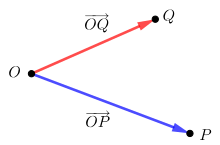Euclidean space
In mathematics, Euclidean space is initially the "space of our conception" as described in Euclid's Elements by axioms and postulates (cf. Euclidean geometry). Until the 19th century, it was assumed that this described the physical space surrounding us. The addition of "Euclidean" became necessary after more general concepts of space were developed in mathematics (e.g. hyperbolic space, Riemannian manifolds) and it became apparent in the context of special and general relativity that other spatial concepts were needed to describe space in physics (Minkowski space, Lorentz manifold).
In the course of time Euclid's geometry was made more precise and generalized in various ways:
- axiomatically by Hilbert (see Hilbert's axiom system of Euclidean geometry),
- as a Euclidean vector space (a vector space defined over
defined vector space with scalar product),
- as a Euclidean point space (an affine space modeled over a Euclidean vector space),
- As the coordinate space
with the standard scalar product.
When talking about Euclidean space, any of these definitions can be meant or also a higher-dimensional generalization. The two-dimensional Euclidean space is also called Euclidean plane. In this two-dimensional case, the term is used somewhat more generally in synthetic geometry: Euclidean planes can there be defined as affine planes over a more general class of bodies, the Euclidean bodies. These bodies are (depending on the view) partial bodies or isomorphic to partial bodies of
Euclidean space differs from affine space in that one can measure lengths and angles. One therefore draws out the mappings that preserve lengths and angles. These are traditionally called congruence mappings, other names are movements and isometries.
In non-Euclidean spaces, such as hyperbolic and elliptic space, the parallel axiom does not hold.
Euclidean vector spaces
See also: Scalar product space
From Euclidean visual space to Euclidean vector space
In analytic geometry, one associates a vector space with Euclidean space. One way to do this is to take the set of parallel displacements (translations), provided with the one behind the other as an addition. Each translation can be described by an arrow connecting a point to its image point. Two arrows, which are parallel in the same direction and have the same length, describe the same displacement. Two such arrows are called equivalent and the equivalence classes are called vectors.
If one chooses a point 




One can now also transfer the length and angle measurement from Euclidean space to vectors as the length of the associated arrows and angles between such. In this way one obtains a vector space with scalar product. The scalar product is characterized by the fact that the product 







Here denotes 


General term
Starting from this, any real vector space with scalar product (of arbitrary finite dimension 




Lengths, angles, orthogonality and orthonormal bases
See also: Orthonormal basis
Once one has provided a real vector space with a scalar product, one can transfer the metric notions of the Euclidean visual space to it. The length (the norm, the magnitude) of a vector 

Two vectors 

The (non-oriented) angle between two vectors is defined by the above formula

Sync and corrections by n17t01

A vector 



The coefficients are obtained by

Isometrics
If 





and angles, i.e. in particular orthogonality
Conversely, any linear mapping that preserves lengths is an isometry.
An isometry maps every orthonormal basis back to an orthonormal basis. Conversely, if 





From this it follows that two Euclidean vector spaces of the same dimension are isometric, that is, they are indistinguishable as Euclidean vector spaces.

Two points and their position vectors

Angle between two vectors
The Euclidean point space
Motivation
Euclidean vector spaces often serve as models for Euclidean space. The elements of the vector space are then called points or vectors, depending on the context. No distinction is made between points and their location vectors. Computationally, this can be advantageous. Conceptually, however, it is unsatisfactory:
- From a geometric point of view, points and vectors should be distinguished conceptually.
- Vectors can be added and multiplied by numbers, but points cannot.
- Points are connected or merged by vectors.
- In the vector space there is a distinguished element, the zero vector. But in Euclidean geometry all points are equal.
Description
The remedy is the concept of a Euclidean point space. This is an affine space over a Euclidean vector space. Here one distinguishes between points and vectors.
- The totality of points forms the Euclidean point space. This is usually denoted by
,
,
or ^{n}} (The superscript
is not an exponent, but an index denoting the dimension. So
is not a Cartesian product).
- The set of all vectors forms a Euclidean vector space
.
- For every two points
and
there exists exactly one connection vector, denoted by
. The connection vector of a point with itself is the zero vector:
- A point
can be uniquely
transformed into a point
by a vector This is often denoted by
. (This is a purely formal notation. The plus sign does not denote vector space addition, nor addition on the point space.)
The zero vector merges every vector into itself: - If the vector
passes the point
to the point
and the vector
passes the point
to the point
, then
transits the point
into the point This can be expressed as follows:
In the language of algebra, these properties mean: The additive group of the vector space 

Lengths, distances and angles
Line lengths, distances between points, angles and orthogonality can now be defined using the scalar product of vectors:
The length 
![[PQ]](https://www.alegsaonline.com/image/1103707481b5a55fd636cb13fdd707c6822b80c6.svg)




The size of the angle 


Two distances ![[PQ]](https://www.alegsaonline.com/image/1103707481b5a55fd636cb13fdd707c6822b80c6.svg)
![[RS]](https://www.alegsaonline.com/image/5c7bd107332a0ad8203392dc1b896bc31b5c4655.svg)


Images
Length-preserving mappings of a Euclidean point space to itself are called isometries, congruence mappings (in plane geometry), or motions. They automatically preserve angles as well. If 



Search within the encyclopedia

















